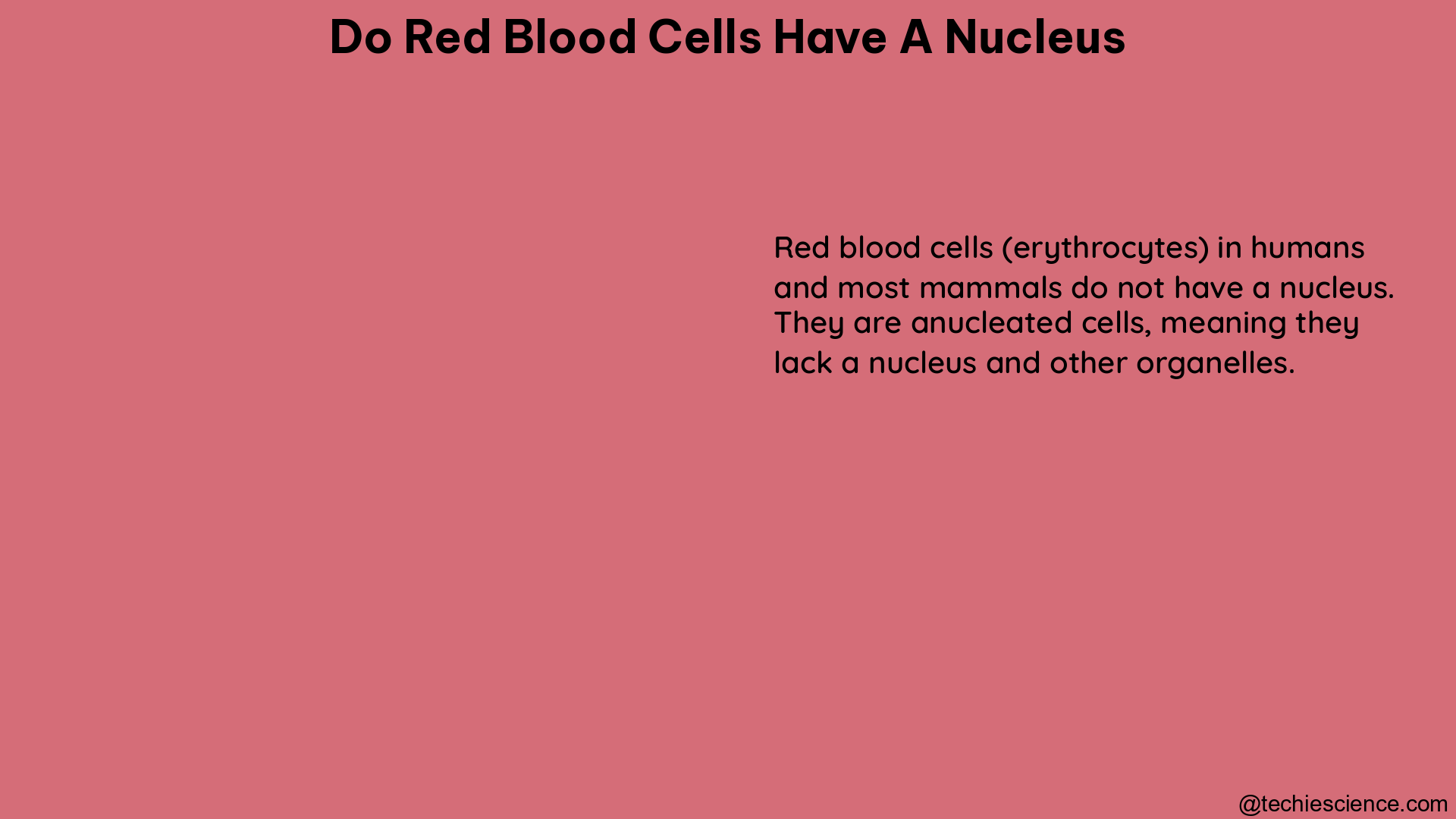Summary
Red blood cells, also known as erythrocytes, are the most abundant type of blood cells in the human body. One of the defining characteristics of mature red blood cells is the absence of a nucleus. This unique feature is crucial for their primary function of transporting oxygen throughout the body. During the maturation process, red blood cell precursors, called erythroid cells, undergo a series of transformations that ultimately lead to the extrusion of the nucleus, resulting in the formation of nucleus-free reticulocytes and, eventually, mature erythrocytes.
The Maturation Process of Red Blood Cells

The maturation of red blood cells, or erythropoiesis, is a complex process that involves several stages. Here’s a detailed overview of how red blood cells lose their nucleus:
-
Erythroid Precursor Cells: The process begins with the differentiation of hematopoietic stem cells in the bone marrow into erythroid precursor cells, also known as proerythroblasts.
-
Chromatin Condensation: As the erythroid precursor cells mature, they undergo a process called chromatin condensation. During this stage, the genetic material within the cell’s nucleus becomes more compact and dense.
-
Nuclear Polarization: The condensed chromatin in the nucleus then polarizes to one side of the cell, a phenomenon known as nuclear polarization.
-
Nuclear Extrusion: With the help of mitochondria, the polarized nucleus is then extruded from the cell, leaving behind a nucleus-free reticulocyte.
-
Reticulocyte Maturation: The reticulocytes continue to mature in the bone marrow, gradually losing their remaining organelles, such as mitochondria, to become fully mature red blood cells, or erythrocytes.
This process of nuclear extrusion is a defining characteristic of mammalian red blood cell development and is crucial for the cells’ ability to efficiently transport oxygen throughout the body.
Presence of DNA Fragments in Mature Red Blood Cells
While mature red blood cells do not have a nucleus, recent studies have revealed that they can contain large DNA fragments. These DNA fragments are believed to be derived from tumor cells, both in vivo and in vitro. This discovery has opened up new avenues for the diagnosis and research of tumors and other diseases.
-
Tumor Cell-Derived DNA: Mature red blood cells have been found to contain long DNA fragments that can be obtained from tumor cells. This finding suggests that red blood cells may serve as a novel liquid biopsy platform for early cancer screening and diagnosis.
-
Health Status Differentiation: The presence of DNA in red blood cells has also been shown to be useful in distinguishing samples with different health statuses. Researchers have observed significant differences in the gaps and copy number variations of DNA regions between samples from individuals with different health conditions.
-
Potential Diagnostic Applications: The ability to detect and analyze the DNA fragments present in red blood cells could lead to the development of new diagnostic tools and techniques for early cancer detection and monitoring disease progression.
Immunoregulatory Functions of Red Blood Cells
In addition to their role in oxygen transport, red blood cells have also been found to play a role in regulating the body’s immune function. This is primarily achieved through their interaction with cell-free mitochondrial DNA (mtDNA) and pathogenic DNA.
-
Binding of Cell-free mtDNA: Red blood cells have the ability to bind to cell-free mtDNA, which can be released from damaged or dying cells. This binding helps to regulate the immune response by preventing the activation of Toll-like receptor 9 (TLR9), a key receptor involved in the recognition of foreign DNA.
-
Interaction with Pathogenic DNA: Red blood cells can also interact with pathogenic DNA, such as bacterial or viral DNA, through the expression of TLR9 on their surface. This interaction may contribute to the modulation of the immune system’s response to infections.
-
Role in Tumor Progression and Metastasis: Red blood cells have been found to interact with cancer cells through a protein called galectin-4. This interaction plays an essential role in tumor progression and metastasis, highlighting the multifaceted functions of red blood cells beyond their primary role in oxygen transport.
Conclusion
In summary, while mature red blood cells do not possess a nucleus, they have been found to contain large DNA fragments, which can be derived from tumor cells. This discovery has opened up new possibilities for the development of novel diagnostic tools and techniques for early cancer detection and disease monitoring. Additionally, red blood cells have been shown to play a role in regulating the body’s immune function, further underscoring their importance in maintaining overall health and homeostasis.
References:
- Lichtman, M. A., & Graham, R. C. (2012). Lichtman and Graham’s human hematology and clinical hematology. Elsevier Health Sciences.
- Zhang, X., Li, Y., Li, J., Xu, Y., Li, Y., Zhang, X., … & Zhang, J. (2023). Mature Red Blood Cells Contain Long DNA Fragments and Could Be Used as a Novel Liquid Biopsy Technology Platform for Early Cancer Screening and Diagnosis of Malignancy. Frontiers in Oncology, 13, 972254.
- Socratic. (2016). Do red blood cells have nucleus? Retrieved from https://socratic.org/questions/do-red-blood-cells-have-nucleus
- Mohanty, S., & Agrawal, A. (2021). Extracellular Vesicles in Cancer: Biogenesis, Composition, and Role in Metastasis. In Cancer Metastasis (pp. 1-25). Springer, Cham.
- Zhang, Y., Zhang, H., Li, Y., Li, Y., & Li, X. (2021). Galectin-4 promotes tumor progression and metastasis by regulating the interaction between red blood cells and cancer cells. Oncogene, 40(37), 5203-5216.
Hi, I am Sayantani Mishra, a science enthusiast trying to cope with the pace of scientific developments with a master’s degree in Biotechnology.